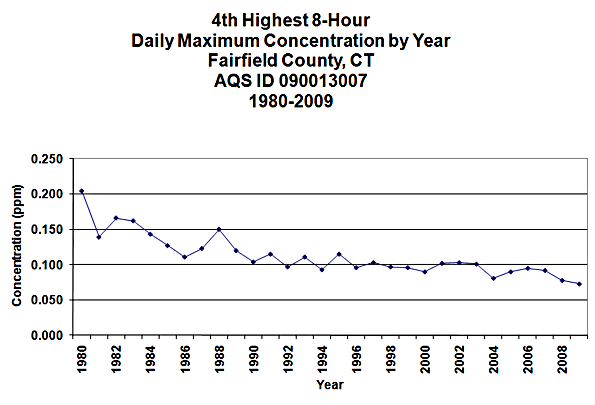The
previous 1-hour primary and secondary federal standards for ozone
were each set at a level of 0.12 ppm. The standards were attained
when the expected number of days per calendar year with maximum
hourly average concentrations above 0.12 ppm was equal to or
less than 1, averaged over 3 years (i.e., no more than 3 exceedances
in 3 years). Current emissions control strategies focus on reducing
the highest hourly average concentrations.
For developing appropriate
emission control strategies for meeting the 8-hour standard,
it is important to identify the unique patterns of hourly average
concentrations that make up the 8-hour violations and to investigate
the importance of mid-range concentrations (i.e., 0.06-0.09 ppm)
in defining these violations. For those sites whose 8-hour violation
is mostly defined by hourly average concentrations below 0.09
ppm, control strategies will have to change from focusing on
the higher hourly average concentrations to the mid-level (i.e.,
0.06 to 0.09 ppm) hourly average values.
Using the EPA's
Aerometric Information Retrieval System (AIRS), renamed the Air
Quality System (AQS), A.S.L. & Associates found that for
the period 1993-1995, approximately 50% of the areas that violated
the 8-hour standard were influenced by 4 or more occurrences
of mid-level hourly average concentrations (i.e., less than or
equal to 0.09 ppm).
In addition, A.S.L.
& Associates identified those sites that demonstrated a significant
reduction in ozone levels for the period 1980-1995. Using the
data from the sites that experienced reduced ozone levels over
the period of time, A.S.L. & Associates investigated whether
the rate of decline of the mid-level hourly average concentrations
was similar to the rate experienced by the high hourly average
concentrations. The analysis indicated that there is a greater
resistance to reducing the hourly average concentrations in the
mid range than the hourly average concentrations above 0.09 ppm.
Figure 1 below is an example that shows that the higher hourly
average concentrations (i.e., above 90 ppb) decreased at a faster
rate (greater negative rate per year) than the hourly average
concentrations in the mid-level range. The numbers of hourly
average concentrations in the low end of the distribution also
decreased. Both the high and low ends of the distribution are
moving toward the center of the distribution.
As control strategies
are implemented, the resistance to lower the higher hourly average
concentrations will be low, but the resistance will increase
as one attempts to reduce the mid-level values. This experience
is similar to a piston compressing against a gas. The resistance
is initially low; however, the resistance increases as the piston
continues to compress against the gas.
Based on this analysis, which used empirical
data, it appears that when control strategies are implemented,
the "piston effect" will cause higher hourly average
concentrations to be reduced faster than the mid-level values.
Similar to the results obtained for the hourly values, the rate
of decline for the 8-hour daily maximum values in the mid range
will be much slower than the higher 8-hour values. Figure 2 illustrates
the slowing down process for Fairfield County, Connecticut. A rapid decrease in the early
years occurred, but less of a decline occurred in the later years.

The year-by-year
figure below illustrates the changes in the 4th highest 8-hour
daily maximum concentration. A rapid decrease in the early years
occurred, but less of a decline occurred in the later years.
For this monitoring site, a weaker statistically significant
downward trend was observed for the 1994-2008 period than for
the 1980-2008 period (-1.07 %/year versus -1.82 %/year, respectively)
(Lefohn et al., 2010).

For some sites that violate the 8-hour
primary standard, the attainment of this standard may be extremely
difficult. A peer-reviewed paper describing the piston effect
and its consequences was published in the June 1998 issue of
Environmental Science & Technology (Lefohn et al., 32(11):276A-282A).
In addition, in 1997, the "Piston Effect" was discussed
in an Atmospheric Environment New
Directions Column.
EPA has commented on the effects of the
"piston effect". In its October 5, 1998 report "Use
of Models and Other Analyses in Attainment Demonstrations for
the 8-Hour ozone NAAQS," the Agency noted
"Analyses of regional modeling results
suggest that relative reduction factors tend to have lower values
(i.e., greater reductions occur) if the starting concentrations
are higher (ECR, 1998; Meyer et al., 1997). Lefohn, et al., (1998)
report similar findings in their review of recent trend data."
Using models, several investigators have
commented on the difficulty in reducing the mid- level hourly
average concentrations while reducing the fourth highest 8-hour
average daily maximum concentration. Saylor et al. (1999)
noted that for the Atlanta, Georgia area, NOx emissions reductions
greater than 60 – 75% would be required to reduce the mid-level
hourly average concentrations. Winner and Cass (2000) noted that
the higher hourly average concentrations were reduced much faster
than the mid-level values during simulation modeling for the
Los Angeles area. Reynolds et al. (2003) analyzed ambient
ozone concentrations used in conjunction with the application
of photochemical modeling to determine the technical feasibility
of reducing hourly average concentrations in central California.
Various combinations of volatile organic compounds and oxides
of nitrogen emission reductions were effective in lowering modeled
peak 1-hour ozone concentrations. However, VOC emissions reductions
were found to have only a modest impact on modeled peak 8-hour
ozone concentrations. Reynolds et al. (2003) reported
that 70 – 90% NOx emissions reductions were required to
reduce peak 8-hour ozone concentrations to the desired level
in central California.
Reynolds et al. (2004) used ozone
measurements in conjunction with photochemical modeling to assess
the feasibility of reducing hourly average concentrations in
the eastern United States. The authors reported that various
combinations of volatile organic compound and oxides of nitrogen
emission reductions were effective in lowering modeled peak 1-hour
O3 concentrations. VOC emission reductions alone had only a modest
impact on modeled peak 8-hour ozone concentrations. Anthropogenic
NOx emissions reductions of 46-86% of 1996 base case values were
needed to reach the desired level of the 8-hour value in some
areas.
Reynolds et al. (2003, 2004) have
commented on possible chemical explanations for the observation
that more prominent trends in peak 1-hour ozone levels than in
peak 8-hour ozone concentrations or in occurrences of mid-level
(i.e., 0.06 – 0.09 ppm) have been reported. The authors
noted that when anthropogenic VOC and NOx emissions are reduced
significantly, the primary sources of ozone precursors are biogenic
emissions and CO from anthropogenic sources. Chemical process
analysis results indicated that slowly reacting pollutant such
as CO could be contributing on the order of 10 – 20% of
the ozone produced. The authors recommended that further work
focus on the need to confirm that biogenic emissions have not
been significantly overestimated in the most recent emission
inventories and on the examination of the effects of CO reductions.
In its review of possible changes to the
federal ozone standard, EPA's results (2014) indicate that the
highest concentrations are reduced faster than the mid-level
concentrations as emission reductions are simulated. Thus, the
"piston" effect has been simulated in the EPA's modeling
results.
If you would like
to read a summary of our May 1997 report describing our findings,
please click here.
References
Lefohn, A.S., Shadwick,
D., Oltmans, S.J. (2010). Characterizing Changes of Surface Ozone
Levels in Metropolitan and Rural Areas in the United States for
1980-2008 and 1994-2008. Atmospheric Environment. 44:5199-5210.
Reynolds, S. D.; Blanchard, C. L.; Ziman,
S. D. (2003) Understanding the effectiveness of precursor reductions
in lowering 8-hr ozone concentrations. J. Air & Waste Manage.
Assoc. 53: 195-205.
Reynolds, S. D.; Blanchard, C. L.; Ziman,
S. D. (2004) Understanding the effectiveness of precursor reductions
in lowering 8-hr ozone concentrations - Part II. The Eastern
United States. J. Air & Waste Manage. Assoc. 54: 1452-1470.
Saylor, R. D.; Chameides, W. L.; Change,
E. C. (1999) Demonstrating attainment in Atlanta using urban
airshed model simulations: impact of boundary conditions and
alternative forms of the NAAQS. Atmos. Environ. 33: 1057-1064.
US Environmental Protection Agency, US
EPA, 2014. Policy Assessment for the Review of the Ozone National
Ambient Air Quality Standards. EPA/452/R-14-006. Research Triangle
Park, NC: Office of Air Quality Planning and Standards. August.
Winner, D. A.; Cass, G. R. (2000) Effect
of emissions control on the long-term frequency distribution
of regional ozone concentrations. Environmental Science &
Technology. 34: 2612-2617.

